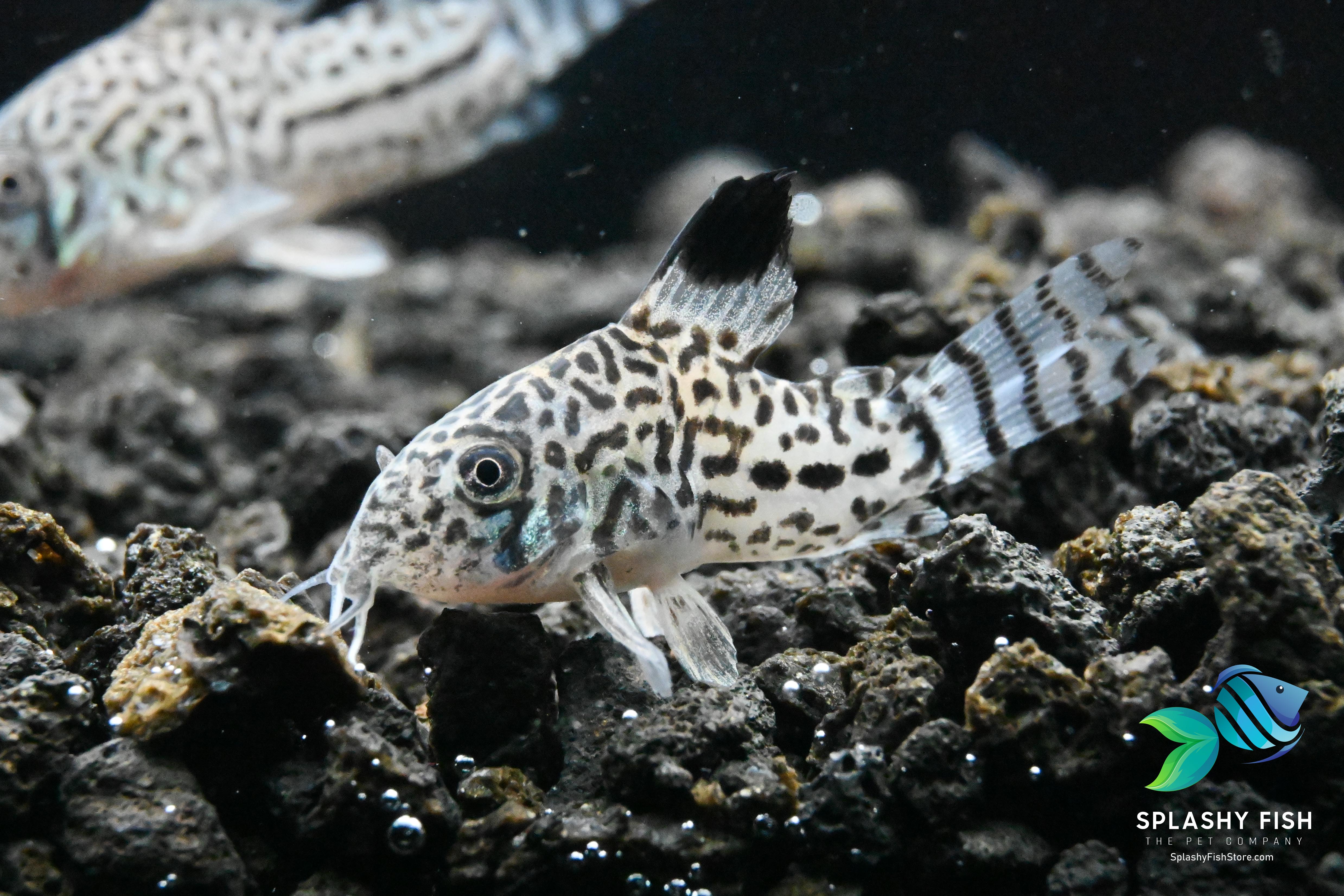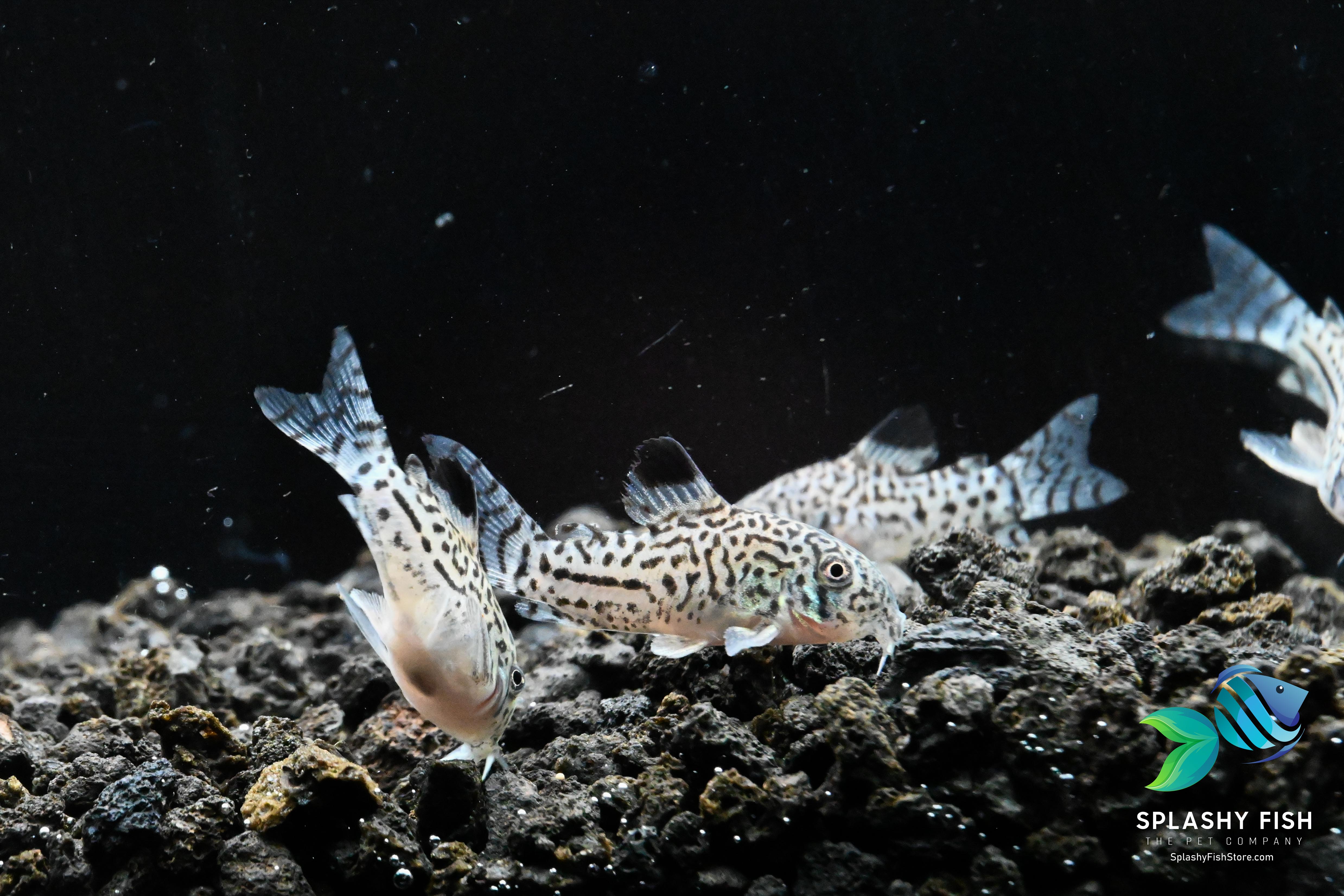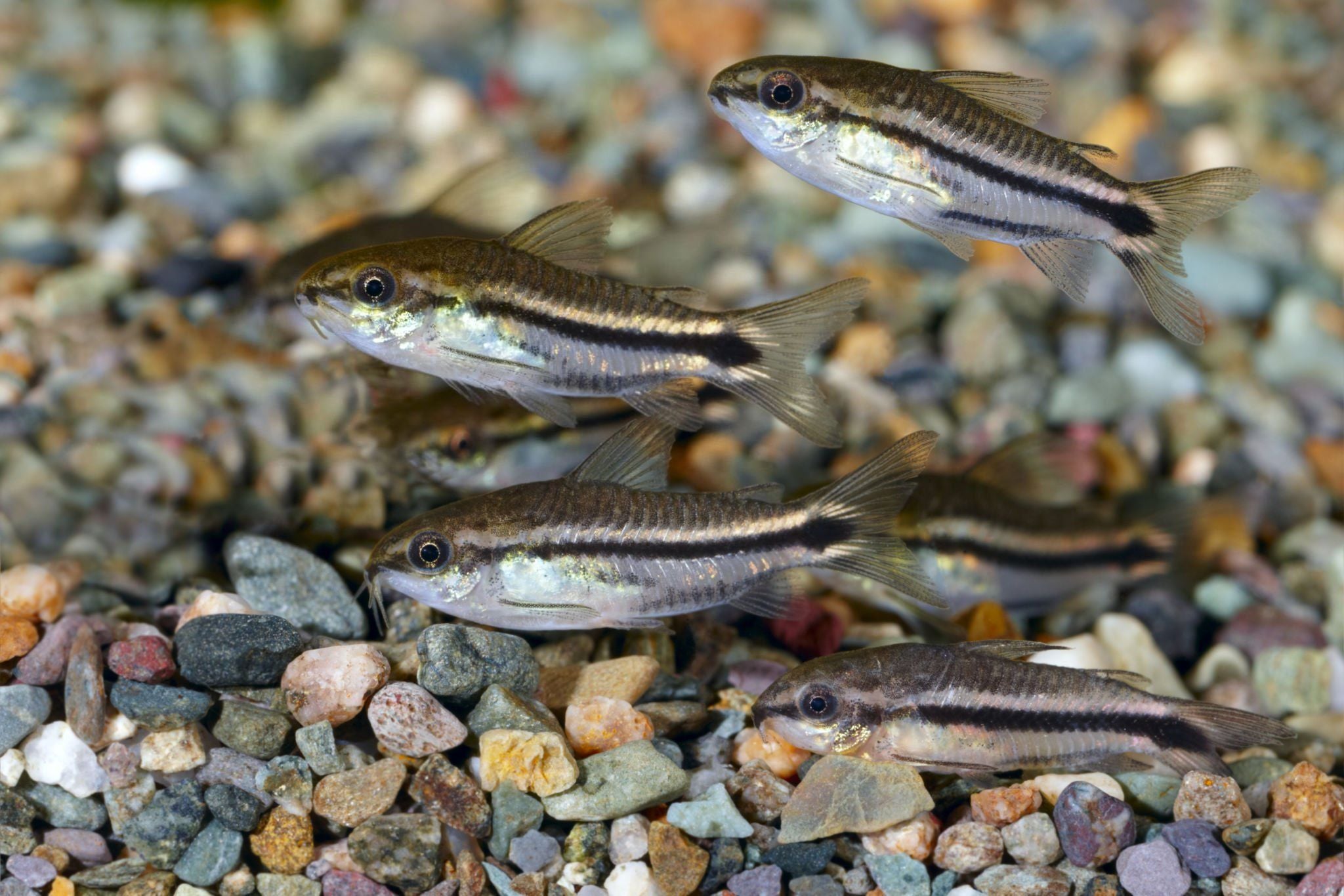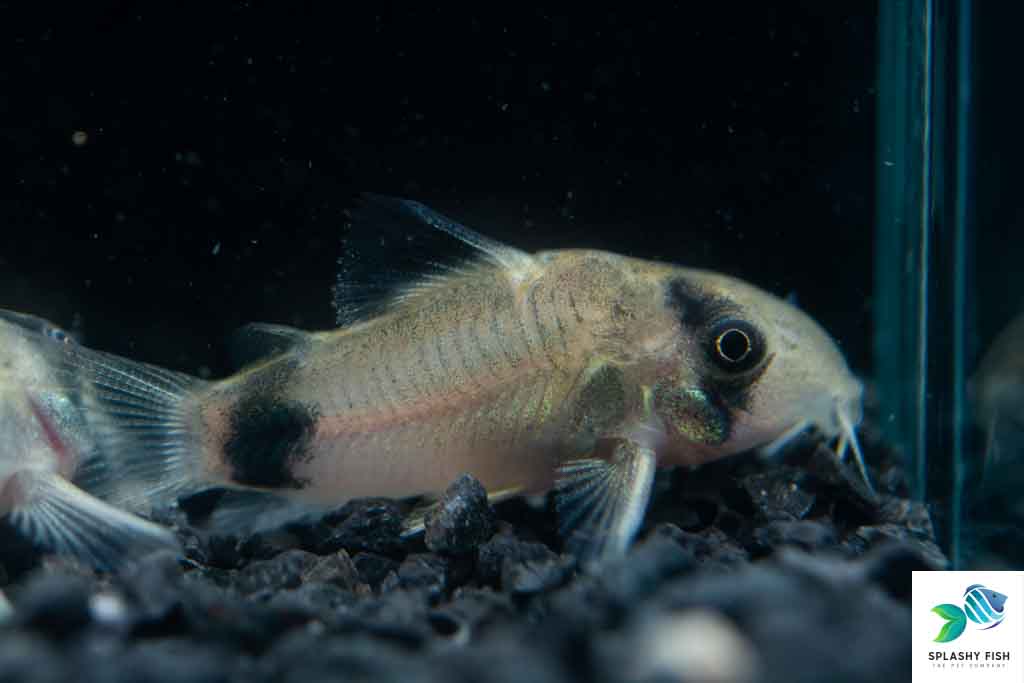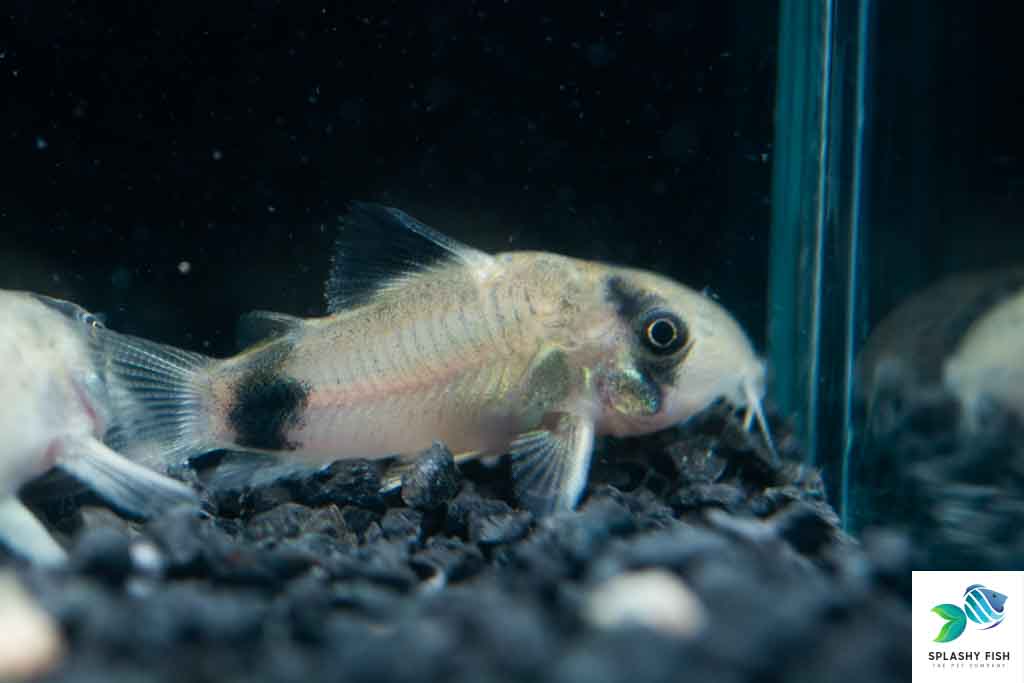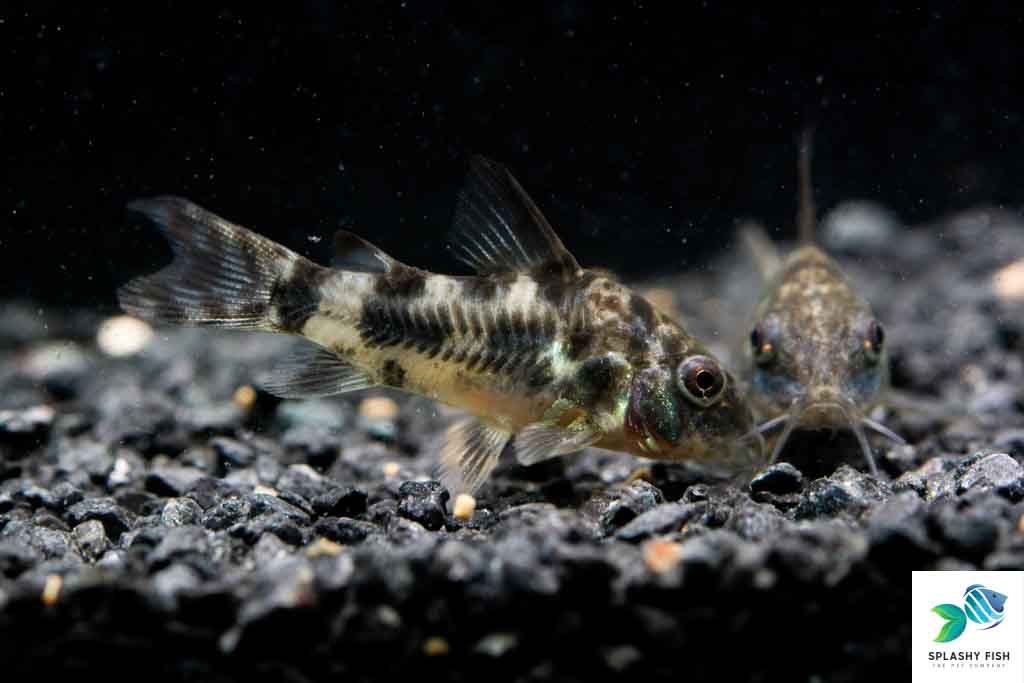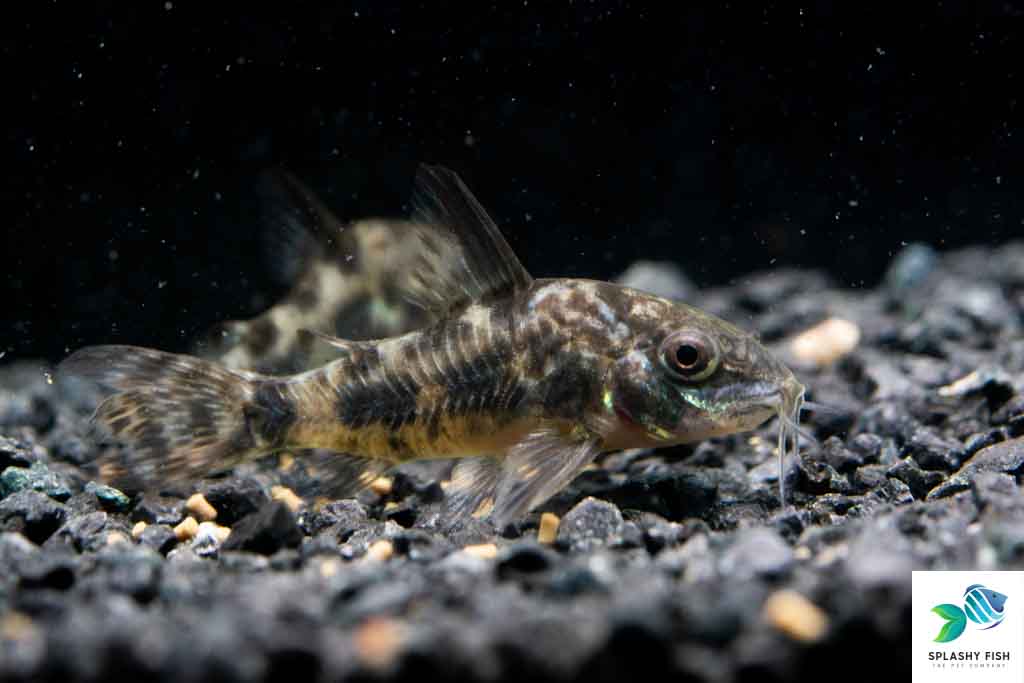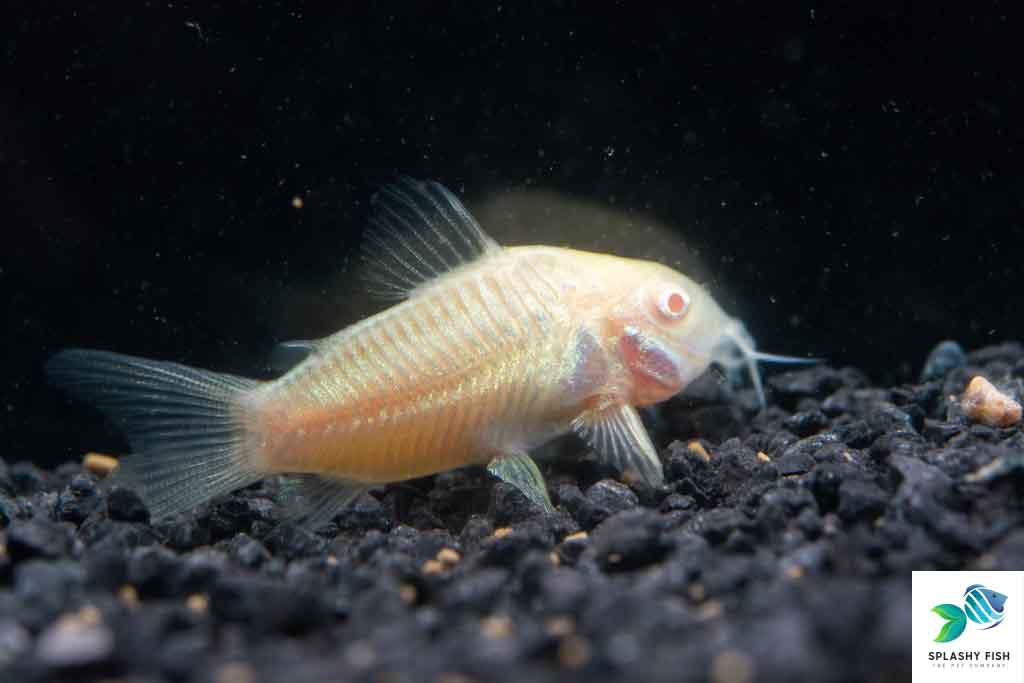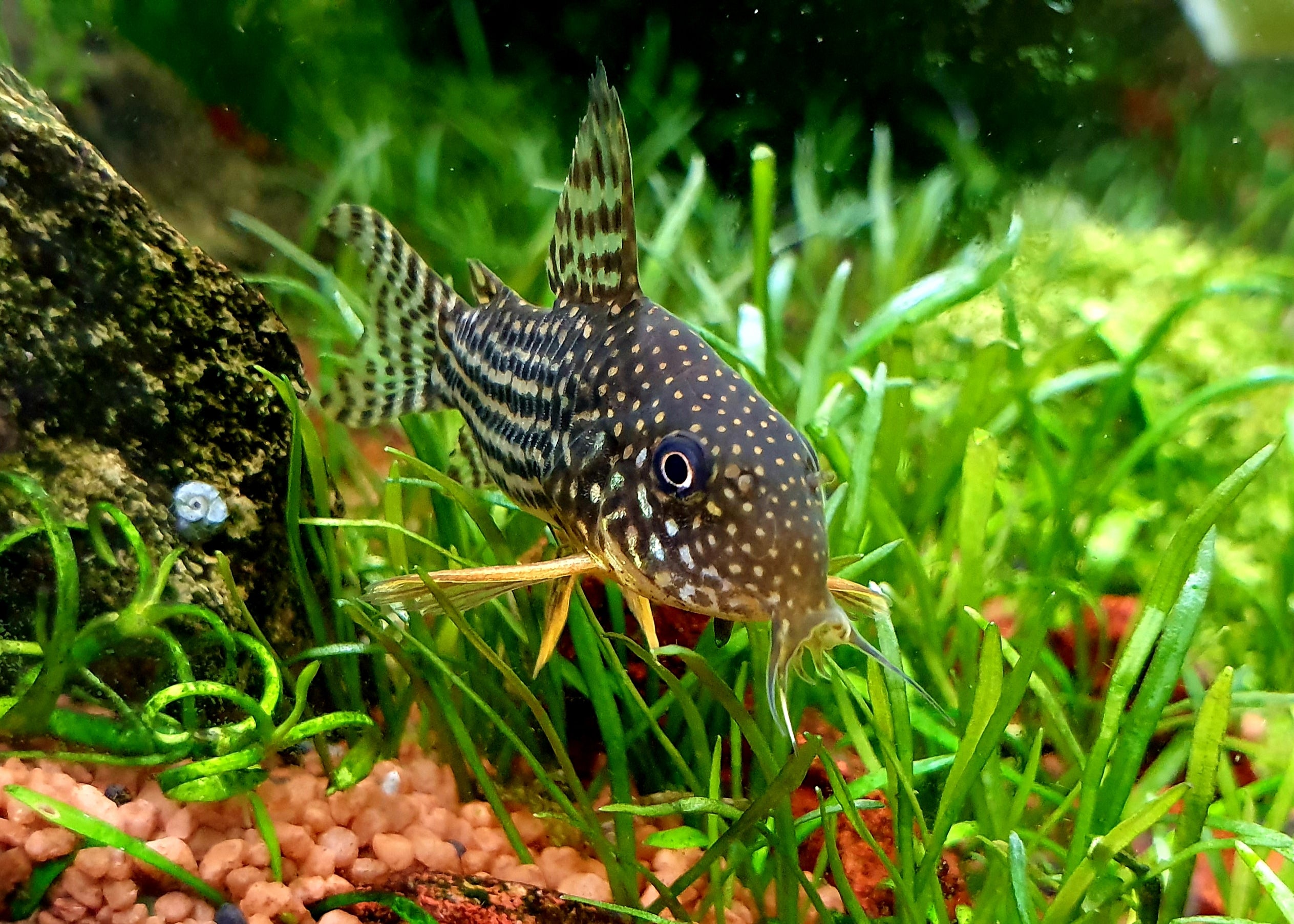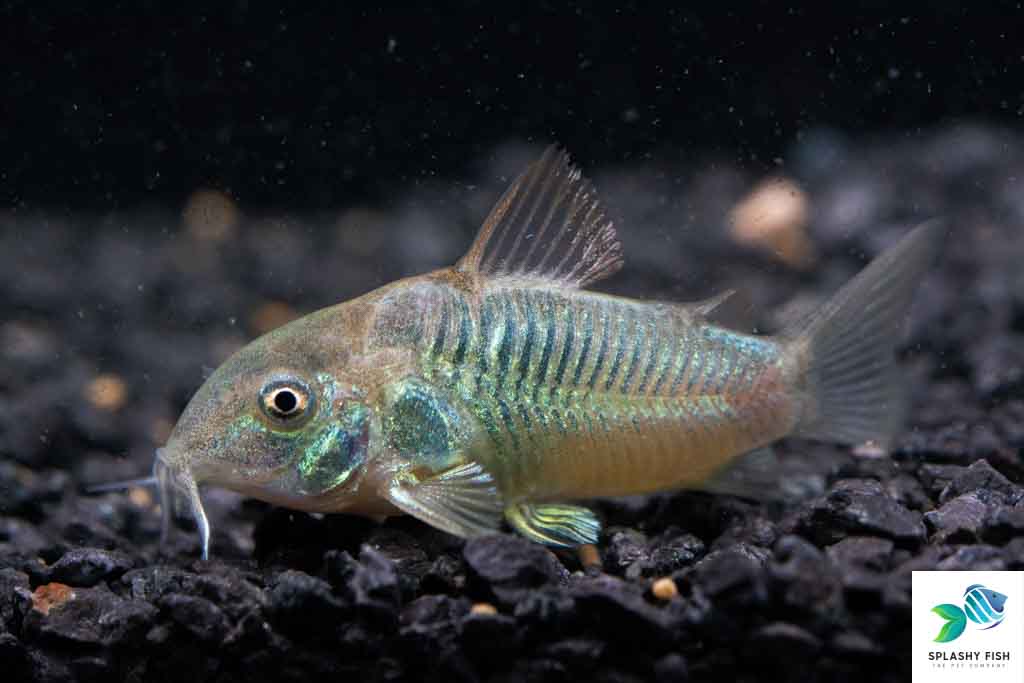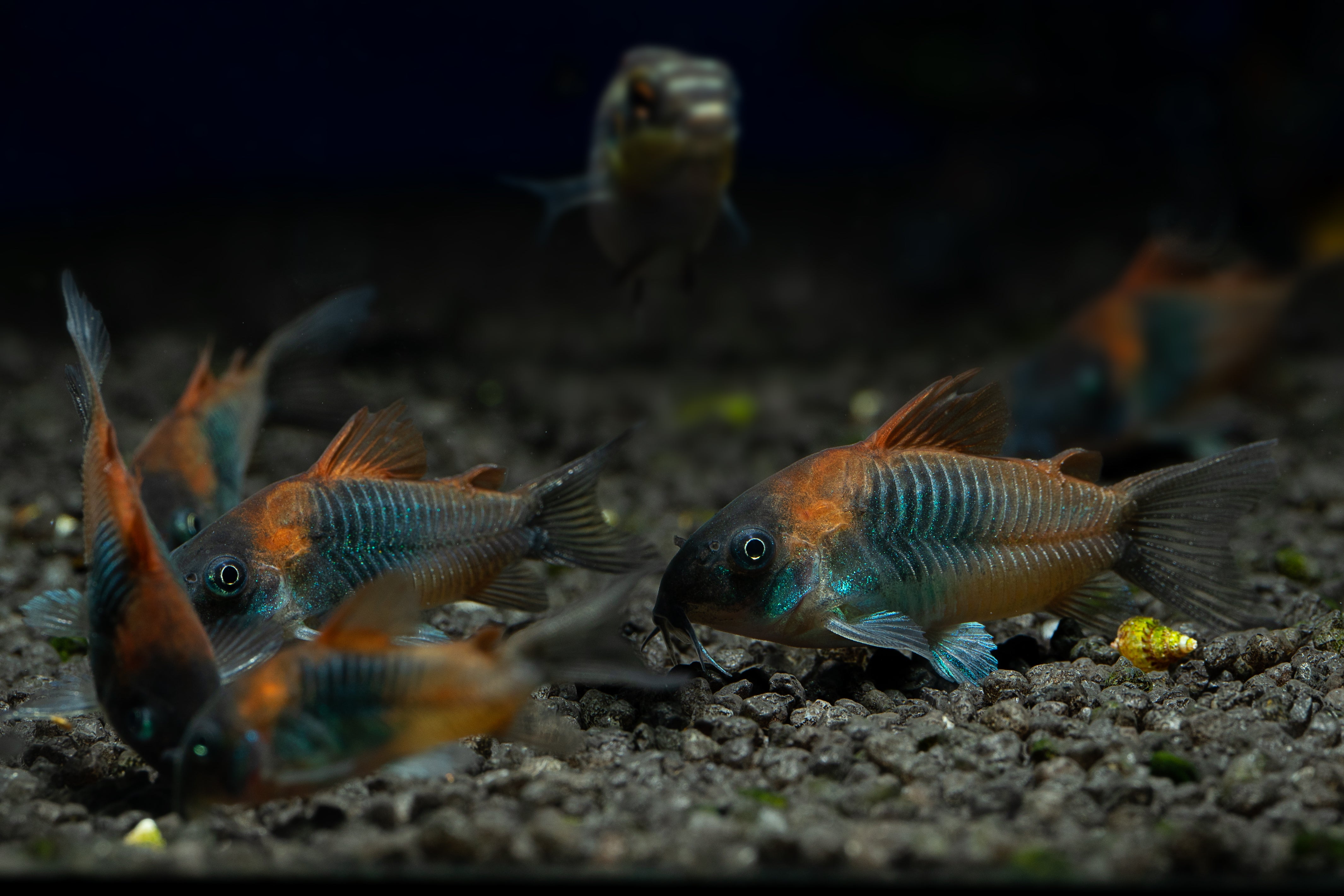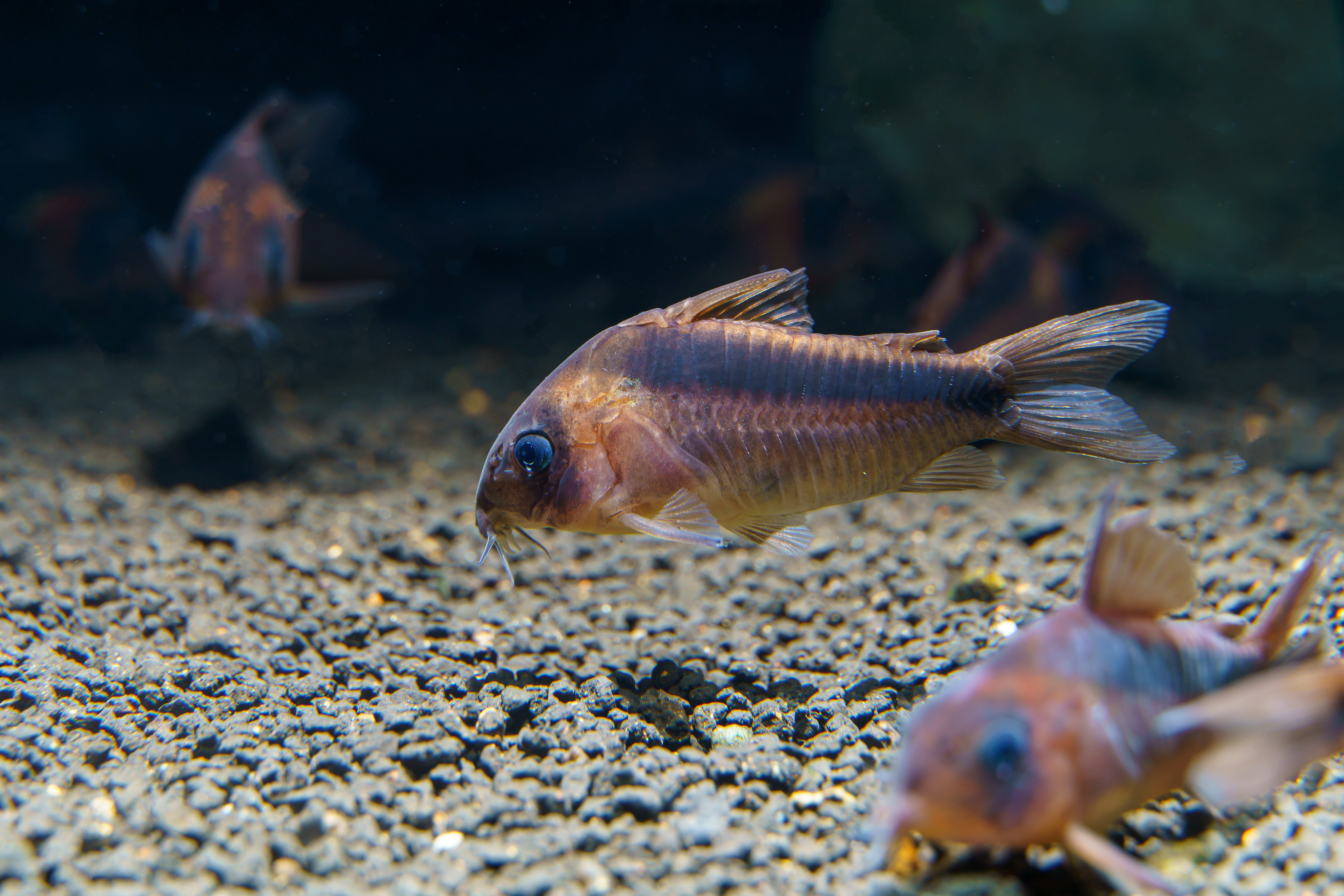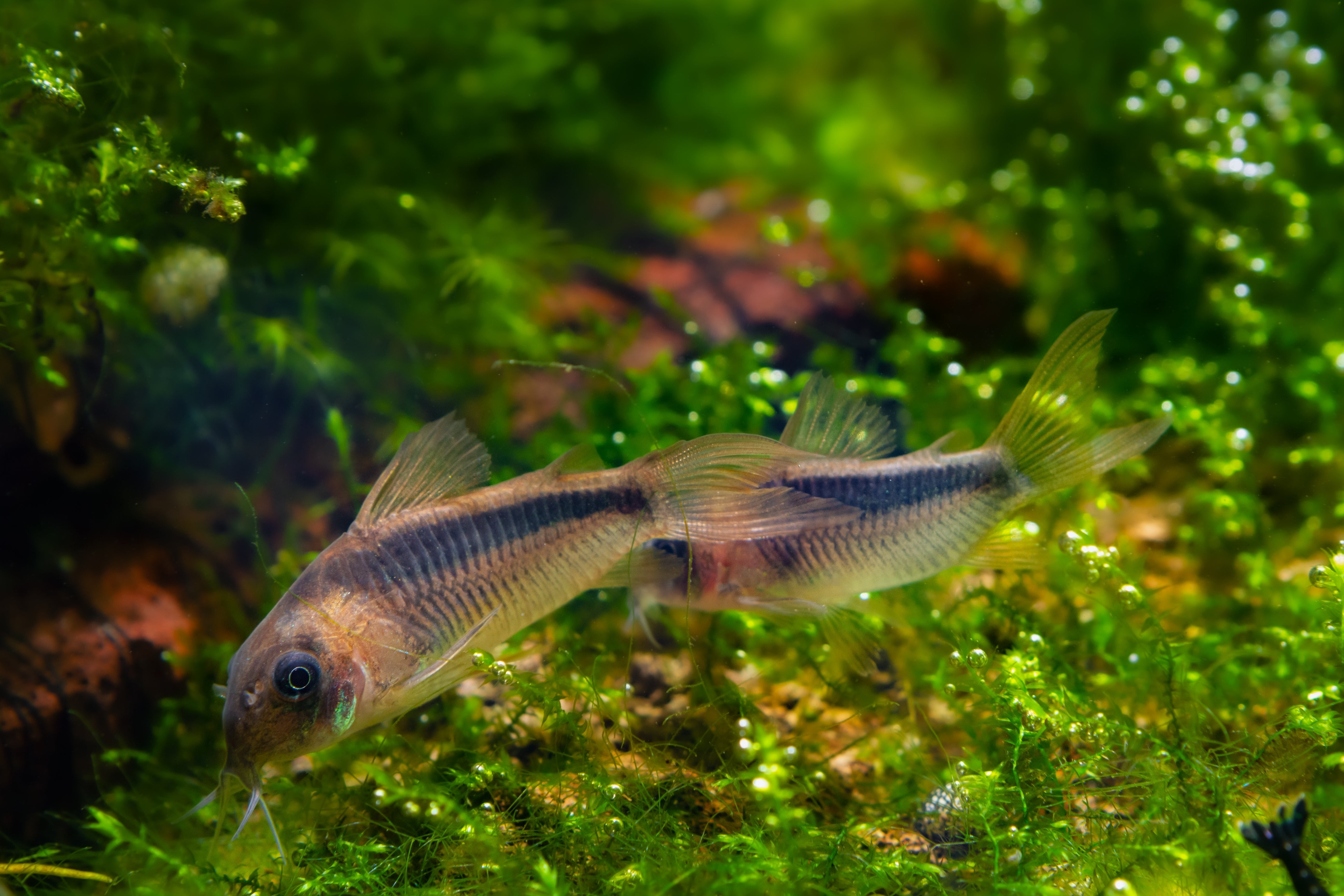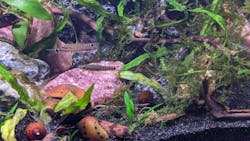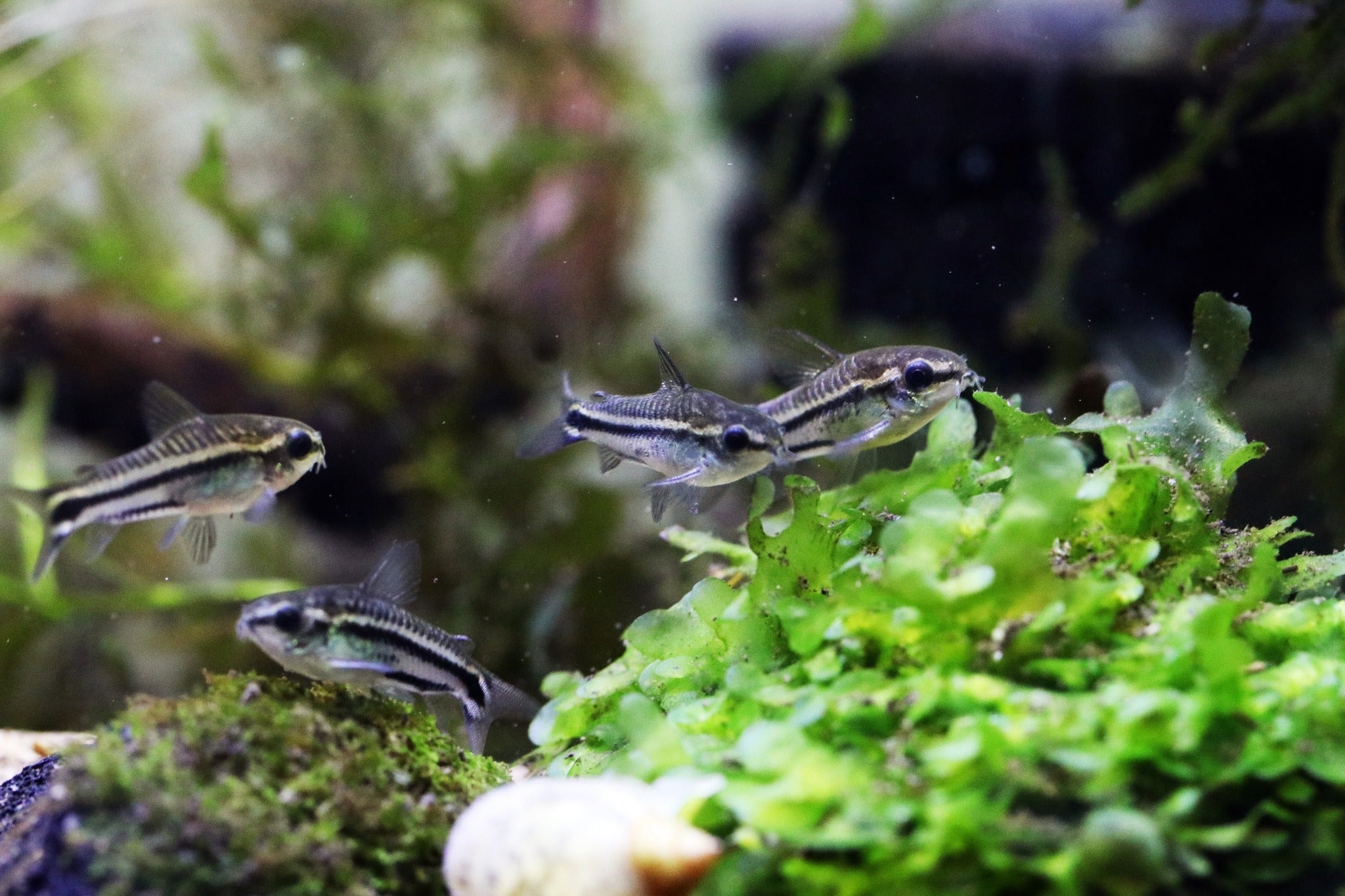
Corydoras Catfish

Corydoras catfish, also known as cory catfish or corydoras, are a popular choice among aquarists due to their small size, hardy nature, and attractive appearance. These freshwater fish are native to South America and are known for their distinctive armor-like plates and bright, colorful patterns. Corydoras fish are generally peaceful and can be kept in a variety of tank setups, including community tanks and planted tanks. They are known to be efficient scavengers and can help keep the substrates and aquarium plants clean by eating algae and detritus. In addition to their functional value, corydoras catfish are also prized for their beauty and can add a touch of color and interest to your tank. With proper care, including a high-quality diet and good water conditions, corydoras fish can make interesting and rewarding pets.
At Splashy Fish tropical fish store, our Cory Catfish for sale are carefully hand-picked and packed with love to ensure they reach you in the best condition. You can buy Corydoras online or visit our fish store in Virginia for a wide range of freshwater fish for sale, live plants for sale, and other aquarium supplies.
Care Guide for Corydoras Catfish
- Tank Size: Corydoras catfish are relatively small fish, but they thrive in groups and require a tank size of at least 10 gallons. Larger tanks are recommended for larger groups.
- Water Parameters: Corydoras catfish prefer soft, slightly acidic water with a pH of 6.0-7.5, water hardness of 2-12 dGH, and a temperature range of 72-78°F (22-26°C).
- Filtration: A gentle filtration system, like a sponge filter or a hand-on-back filter with a low flow rate, is ideal for Corydoras catfish. Ensure good water quality with regular water changes.
- Substrate: Choose a soft, sand-like substrate to protect their delicate barbels. Avoid sharp gravel that could damage their whiskers.
- Aquarium Plants: Corydoras catfish enjoy exploring and hiding among aquatic plants. Provide a variety of plants, including low-lying options like Java moss, Marimo Moss Balls or Anubias, for them to feel secure.
- Lighting: Moderate aquarium lighting is sufficient for Corydoras catfish. Avoid excessively bright lights, which may cause stress.
- Diet: Corydoras catfish are omnivores and relish sinking pellets, wafers, and live or frozen foods like bloodworms, brine shrimp, and daphnia. Ensure their food reaches the bottom of the tank.
- Breeding: Corydoras catfish are relatively easy to breed. Provide plenty of hiding spots and spawning mops. Conditioning them with a varied diet can induce spawning behavior.
Corydoras Frequently Asked Questions (FAQs):
Can Corydoras Catfish live with Bettas?
Yes, Corydoras can often coexist peacefully with Bettas in a well-planted tank with ample hiding places for both species. However, monitor their interactions closely to ensure there is no aggression.
Are Corydoras Catfish schooling fish?
Yes, Corydoras are social fish and thrive in groups of at least six or more individuals. Keeping them in larger groups encourages natural behavior and reduces stress.
Are Corydoras Catfish hard to keep?
Corydoras are generally easy to care for and make excellent additions to community tanks with peaceful species. As long as their basic needs are met, they are hardy and adaptable fish.
Dive into the Fascinating World of Corydoras: Unveiling the Secrets of these Captivating Aquarium Fish
Welcome to the captivating world of Corydoras fish! These mesmerizing live freshwater fish never fail to impress with their unique and engaging behaviors. In this article, we will dive deep into the secrets of Corydoras, uncovering the fascinating aspects that make them such popular choices among hobbyists and aquarium fish enthusiasts. From their distinctive appearance to their intelligent and social nature, Corydoras have captured the hearts of aquarium lovers worldwide. These charming fish belong to the catfish family, and their playful antics and curious nature make them a joy to observe. Whether you're a seasoned aquarist or an aquarium beginner, this article will provide you with the insights and knowledge to create the perfect environment for your Corydoras. Join us as we explore the various species and their specific care requirements, including tank setup, diet, and preferred companions. Discover tips and tricks for maintaining their optimal health and learn how to breed Corydoras successfully. So, prepare to be amazed by the incredible world of Corydoras. Get ready to uncover the secrets that lie beneath the surface and embark on a journey of wonder and fascination with these captivating aquarium fish.
Setting up a freshwater aquarium for Cory Catfish: Tips on fish tank size, water conditions, and natural decorations
Creating a well-thought-out aquarium tank environment is essential for the health, happiness, and longevity of Corydoras. These live freshwater fish thrive when their habitat mimics their natural conditions, so careful attention to tank size, water parameters, and natural decorations is vital. Here’s a step-by-step guide to setting up an ideal home for your Corydoras:
1. Choosing the Right Aquarium Tank Size
Corydoras are social freshwater fish that should always be kept in groups of six or more. To accommodate their shoaling behavior and ensure ample space for exploration:
- Minimum Aquarium Tank Size: A 20-gallon tank is the absolute minimum for a small group of 6–8 Corydoras. For larger groups or if you plan to add other species, consider a 30-gallon tank or larger.
- Aquarium Tank Dimensions: Opt for a tank with a wider footprint rather than extra height. Corydoras spend most of their time at the bottom, so horizontal swimming space is more important than vertical height.
2. Optimizing Water Conditions
Corydoras are sensitive to water quality, and maintaining stable conditions is key to their well-being:
- Temperature Range: Keep the water temperature between 22–26°C (72–79°F). Use a reliable aquarium heater to maintain consistent temperatures, especially in cooler climates.
- pH Levels: Maintain a slightly acidic to neutral pH range of 6.0–7.5. Test the water regularly to avoid fluctuations.
- Water Hardness: Soft water is preferred, with a general hardness (GH) of 2–12 dGH and carbonate hardness (KH) of 1–5 dKH.
- Aquarium Filtration: Use a gentle aquarium filter with a sponge or pre-filter to prevent strong currents that could stress Corydoras. They prefer calm water with adequate oxygenation.
- Aquarium Water Changes: Perform regular partial water changes (20–30% weekly) to keep nitrate levels low and maintain optimal water quality.
3. Designing the Aquarium Tank Layout For Stunning Display
Corydoras thrive in environments that replicate the calm, vegetative, and sandy-bottomed conditions of South American rivers. Include the following elements in your tank setup:
- Aquarium Substrate: Use fine sand as the substrate to protect their sensitive barbels. Avoid sharp aquarium gravel or coarse substrates, as these can cause barbel erosion or injury.
- Live Aquarium Plants: Incorporate live aquarium plants like Amazon swords, Java ferns, or Anubias plants, which provide shelter and oxygen. Floating plants such as red root floater or duckweed can diffuse aquarium light and replicate the shaded conditions of their natural habitat.
- Hiding Spots: Add driftwood, smooth aquarium stones, and small caves for hiding and resting. Corydoras enjoy exploring sheltered areas and need a place to retreat when stressed.
- Open Swimming Areas: Leave sections of the fish tank clear of natural decorations to provide open spaces for their active foraging and social behaviors.
4. Aquarium Lighting and Freshwater Aquascaping Tips
- Use moderate aquarium lighting to avoid stressing the fish, as they prefer subdued conditions.
- For a natural aesthetic, consider natural aquascaping with driftwood and aquatic plants to create layers and depth in the aquarium tank.
By following these detailed guidelines, you can provide a comfortable, safe, and stimulating environment where your Corydoras will not only survive but thrive. The effort you invest in creating the perfect aquarium tank will be rewarded with the joy of observing these charming freshwater fish at their best.
Corydoras habitat and behavior: Understanding their natural environment and social interactions
Corydoras are fascinating freshwater fish native to the streams and rivers of South America, where they inhabit diverse environments ranging from slow-moving tributaries to floodplains. Their natural habitats are typically characterized by soft, sandy substrates, abundant aquatic vegetation, and calm waters with minimal current. These settings not only provide shelter and fish food but also facilitate their social behaviors and group dynamics.
Corydoras are bottom-dwelling fish that rely heavily on their barbels—sensitive, whisker-like structures near their mouths—to explore their environment and locate food particles buried in the aquarium substrate. They exhibit a strong shoaling instinct, meaning they feel safer and more comfortable when kept in groups. Ideally, they should be housed in schools of at least six or more individuals to replicate their natural social structure. This shoaling behavior allows them to navigate their environment together, enhancing their sense of security and encouraging their playful interactions.
Their behavior is a delight to observe. You’ll often find them swimming in tight formations, gently sifting through the aquarium substrate for fish food, or resting collectively under the shade of live aquarium plants or natural decorations. These synchronized movements and curious antics highlight their intelligent and cooperative nature, making them a joy for any aquarist.
Feeding Corydoras: The ideal diet and feeding schedule for these live freshwater fish
Providing a balanced and varied diet is essential for keeping Corydoras healthy, active, and vibrant. As omnivores, they require a mix of proteins and plant-based foods to meet their nutritional needs. Here’s how to ensure your Corydoras are well-fed and thriving.
1. Understanding Their Dietary Needs
Corydoras naturally forage for food at the bottom of the tank, using their sensitive barbels to detect small particles of food. Their diet in the wild consists of insect larvae, small crustaceans, plant matter, and detritus. To replicate this in captivity:
- Protein-Rich Foods: Include Live and Refrigerated Foods such as bloodworms, brine shrimp, daphnia, tubifex worms
- Commercial Foods: Use high-quality sinking pellet food or wafers designed for bottom-feeders. These should contain a balanced mix of proteins, vitamins, and minerals.
- Plant-Based Foods: Supplement Corydoras' diet with blanched zucchini slices, blanched spinach, and peeled peas for fiber and nutrients. Ensure fish food sinks to the bottom and remove leftovers after a few hours.
2. Feeding Schedule and Portion Sizes
- Frequency: Feed your Corydoras 1–2 times daily. Split feedings into smaller portions if offering food twice a day.
- Portion Size: Provide only what they can consume within 3–5 minutes. Avoid overfeeding, as uneaten food can decay and degrade water quality.
- Food Placement: Since Corydoras are bottom-feeders, ensure food sinks to the bottom. Using specialized sinking pellets ensures they can access their meals without competition from mid- or surface-dwelling tank mates.
3. Tips for Effective Fish Feeding
- Rotate Their Diet: Alternate between commercial pellets, live or frozen protein sources, and blanched vegetables to provide variety and prevent nutritional deficiencies.
- Feed in a Quiet Setting: Corydoras are more active during feeding times when the environment is calm. Avoid sudden movements near the aquarium tank that could startle them.
- Night Feeding: If tank mates are competing for food, feed Corydoras in the evening when aquarium lights are dim or off, as they are more active in low-light conditions.
4. Observing Their Eating Habits
Monitor your Corydoras during feeding to ensure all individuals are eating. If you notice:
- Uneaten Food: Remove it promptly to maintain water quality.
- Poor Appetite: Check water parameters and overall health. Stress or illness can lead to reduced eating.
By following this feeding guide, you can ensure your Corydoras receive the balanced nutrition they need to remain healthy and active. Proper feeding not only supports their growth and longevity but also enhances their natural behaviors, making them even more enjoyable to watch in your aquarium.
Corydoras breeding: Insights into the breeding habits and techniques for successful reproduction
Breeding Corydoras can be a fulfilling and exciting process for aquarists, but it requires careful planning and attention to their specific needs. Here’s how to ensure success:
1. Preparation: Conditioning the Breeding Group
- Select Healthy Fish: Choose a group of 4–6 Corydoras, ideally with a mix of males and females. Females are usually larger and rounder than males.
- Diet: Provide a protein-rich diet for 1–2 weeks to condition the fish for spawning. Offer live or frozen foods like bloodworms, daphnia, and brine shrimp alongside their usual pellets or wafers. This mimics the natural abundance of food before the rainy season.
- Aquarium Tank Setup: Ensure the breeding tank has soft, slightly acidic water (pH 6.0–7.0), a temperature of 22–24°C (72–75°F), and fine aquarium sand or smooth gravel as the substrate.
2. Spawning Conditions: Mimicking the Rainy Season
- Water Temperature: Lower the water temperature by 2–3°C (approximately 68–72°F) over a few days to mimic the cooling effect of rain.
- Water Changes: Perform frequent partial water changes (10–20%) with slightly cooler water to simulate fresh rainfall. This triggers spawning instincts.
- Oxygen Levels: Increase aeration using an air stone or by adjusting the aquarium filter flow to ensure high oxygen levels.
- Aquarium Lighting: Provide dim lighting and add plenty of live aquarium plants or spawning mops to encourage the freshwater fish to lay eggs on surfaces.
3. Observing Spawning Behavior
During spawning, males will chase the females in a "T-position," with the male clasping the female's barbels. The female will then lay sticky eggs, often attaching them to plants, glass, or decorations in the fish tank.
4. Caring for the Eggs
- Egg Collection: Carefully remove the eggs using a soft brush or your fingers, as Corydoras or other tank mates may eat them.
- Separate Aquarium Tank: Transfer the eggs to a dedicated hatching tank with similar water conditions to protect them from predation.
- Gentle Aeration: Use an air stone near the eggs to keep water flowing gently around them and prevent fungal growth.
- Antifungal Treatment: Add a few drops of methylene blue to the water to minimize the risk of fungal infections.
Creating the ideal environment for Corydoras breeding and raising their fry successfully requires patience and care. This rewarding process deepens your understanding and appreciation of these fascinating freshwater fish.
Common diseases and health issues: How to identify and treat common ailments in Corydoras
Corydoras are generally hardy and resilient, but they can occasionally encounter health issues if their environment isn’t well-maintained. Understanding these common ailments and knowing how to address them is key to ensuring the health and happiness of your pet fish.
Barbel Erosion is a common issue in Corydoras, particularly when water quality is poor or the tank substrate is sharp. This condition damages their sensitive barbels, making it difficult for them to forage. Symptoms include shortened or damaged barbels and potential secondary infections around the mouth. To address this, improve water quality by performing a 30% water change and stabilizing parameters, ensuring ammonia and nitrites are at zero and nitrates remain below 20 ppm. Replace coarse gravel with fine aquarium sand to prevent further injuries, and treat any secondary infections with antibacterial medications like Melafix. Regular maintenance and choosing the correct aquarium substrate are essential preventative measures to keep this problem at bay.
Fungal infections often manifest as white, cotton-like growths on the skin, fins, or gills of Corydoras. These infections typically occur due to stress, injuries, or contaminated water. Infected fish may also show signs of lethargy or fin damage. To treat fungal infections, move affected fish to a quarantine tank and treat with antifungal medications such as methylene blue or commercial remedies. Thoroughly clean the main tank to prevent recurrence, removing any decaying organic matter or unclean decorations. To avoid fungal issues, maintain proper water hygiene, quarantine new freshwater fish, and reduce stressors in your tank.
Ich, or white spot disease, is another common problem caused by a parasitic protozoan. This condition presents as small white spots resembling grains of salt on the body and fins. Infected Corydoras may rub against surfaces (flashing) and show labored breathing. To treat ich, gradually raise the tank temperature to interrupt the parasite’s life cycle, ensuring this temperature is safe for all tank inhabitants. Combine this with ich-specific medications, such as those containing malachite green or formalin. Increasing aeration during treatment is crucial since higher temperatures reduce oxygen levels in the water. Prevent ich by quarantining new freshwater fish, cleaning equipment, and maintaining stable, clean water conditions.
Preventative care is the best defense against these common diseases. Regular water changes, aquarium substrate maintenance, and balanced feeding routines are foundational to keeping Corydoras healthy. Observing your pet fish closely for early signs of illness allows you to address issues before they become severe. A well-maintained tank with a stress-free environment will ensure your Corydoras thrive, bringing endless joy to your aquatic hobby.
Tank Mates for Corydoras: Creating a Peaceful and Harmonious Aquarium
Corydoras are known for their peaceful nature, making them ideal companions in a community tank. When choosing tank mates, it’s essential to consider species that are non-aggressive and won’t compete for space at the bottom of the aquarium tank, where Corydoras spend most of their time. Pairing them with the right fish not only ensures harmony but also enhances the beauty of your aquarium, especially when combined with planting live aquarium plants.
1. Ideal Tank Mates for Corydoras
Corydoras thrive when housed with freshwater fish that share their calm temperament and prefer different swimming levels in the tank. Some excellent choices include:
- Small Tetras: Neon tetras and cardinal tetras are colorful, peaceful, and remain in the mid-levels of the fish tank, complementing the Corydoras' bottom-dwelling habits.
- Rasboras: Harlequin or strawberry rasboras are active yet gentle freshwater fish that add movement to the upper and middle parts of the aquarium tank.
- Dwarf Gouramis: These small, vibrant fish are slow-moving and non-aggressive, making them ideal companions.
Pro Tip: Adding live aquatic plants in fish tanks, such as Java ferns or Anubias, can enhance the visual appeal and provide natural hiding spots for all fish species.
2. Avoiding Aggressive or Incompatible Species
Not all fishwater fish are suitable tank mates for Corydoras. Avoid species that are:
- Aggressive or Territorial: Fish like cichlids or bettas may bully or stress Corydoras.
- Bottom-Dwellers: Loaches or plecos may compete for fish food and space at the bottom, leading to stress or injury.
3. Enhancing Harmony with Live Aquatic Plants in an Aquarium
Introducing live plants for an aquarium not only mimics a natural habitat but also creates a peaceful environment where freshwater fish can thrive. Here’s how planting live aquarium plants benefits your community tank:
- Natural Cover: Live plants like Amazon swords or crypts provide shaded hiding spots for Corydoras and their tank mates, reducing stress and enhancing their natural behaviors.
- Improved Water Quality: Live fish tank plants absorb nitrates and other toxins, maintaining a healthy ecosystem.
- Aesthetic Appeal: Planting aquarium spaces with greenery adds depth and vibrancy, making your tank a beautiful centerpiece.
When planting aquarium plants, consider the placement of species to create open swimming areas and shaded corners, ensuring a balanced habitat for all freshwater fish.
Conclusion: Final thoughts on the rewarding experience of keeping Corydoras in your aquarium
Corydoras are not just aquarium fish; they are lively, intelligent companions that bring charm and character to any aquatic environment. From their playful interactions and social behaviors to their fascinating breeding habits, Corydoras captivate the hearts of aquarists at every level. Creating a thriving home for them involves more than just providing a aquarium tank—it’s about building a balanced aquarium ecosystem that mimics their natural habitat, complete with optimal water conditions, compatible tank mates, and lush live aquarium plants that enhance their environment.
By investing time and care into their tank setup, feeding, and maintenance, you’ll not only ensure their well-being but also unlock the rewarding experience of observing their vibrant personalities and behaviors. Corydoras teach us about the beauty of nature and the importance of harmony in ecosystems, making them a truly special addition to your aquarium.
Whether you’re a seasoned hobbyist or just starting your journey, keeping Corydoras promises a world of fascination and joy. Dive in, and let these charming fish inspire and enrich your underwater adventure.




















